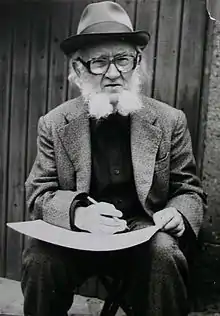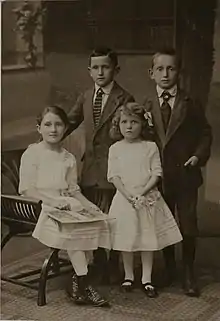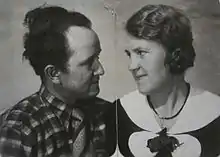
Otto Müller (November 21, 1898 – December 9, 1979) was a German painter and graphic designer.
Life and work
Parental home

Müller was born on November 21, 1898, in Cröllwitz, which since 1900 was a part of the city of Halle, Saxony-Anhalt. He was the first child of the engine driver Karl Christoph Friedrich Otto Müller (1874–1951) and Anna Müller, née Schmidt (1876–1923). He had one brother and two sisters.
Education
Müller went to school in Halle for eight years. He went to train as a lithographer from 1913 to 1917. During this period, he also attended evening classes in drawing and painting at the Staatliche Städtische Handwerkerschule, later known as the Kunstgewerbeschule Burg Giebichenstein (Burg Giebichstein Academy of Arts and Crafts), in Halle.
During the First World War in 1918, Müller was called up to serve on the Western Front in France.
After being demobilised in 1919, he started studying painting at the Burg Giebichenstein Academy of Arts and Crafts, where he was a student of Professor Erwin Hahs (1887–1970). During this period, he formed strong and lasting friendships with fellow students Paul Zilling (1900–1953) and Helmut Schröder (1910–1974). In 1927, both Müller and Helmut Schröder joined a class taught by Charles Crodel, newly appointed to Burg Giebichstein as professor for painting and graphics. During his time in Charles Crodel's class, Müller befriended Kurt Bunge (1911–1998). In different ways, Erwin Hahs and Charles Crodel both influenced Müller's artistic development. Müller came to see a precise study of nature as the basis for all artistic work. Müller is also indebted to Erwin Hahs for training his formal means of expression in terms of a constructive composition encompassing abstract art. Loosely composed, often highly colourful and reminiscent of impressionism, Crodel's paintings provided Müller with fresh artistic impetus.
To fund his training at Burg Giebichenstein, Müller was forced to interrupt his studies for lengthy periods on several occasions. From 1920 to 1922 and from 1924 to 1925, he worked as a painter in the Leuna works. He spent the period of economic depression in 1923 and 1924 on the “waltz”. In Göttingen, he worked as a stage painter at the Deutsches Theater. His journeying took him to Southern Germany, where he found work in Kochel am See on the construction of the Walchensee Hydroelectric Power Station. In 1929, he sat and passed the painter's trade examination with the stage decorator O. Möllhoff in Halle.
Professional and family life 1930–1945
In 1930, Müller entered employment in the paint factory at the "Technische Chemikalien- und Compagnie GmbH" in Halle as a laboratory technician and departmental manager.

In 1936, Müller married Senta-Luise Demmer. They had two children.
During the Second World War, Müller served from 1938 to 1940 in the German defensive line known as the Westwall.
From 1941 to 1945, he worked as a draughtsman at the Siebel aircraft plant in Halle and was exempt from military service for the rest of the war.
Professional and family life 1945–1963
In 1945, Müller began working as a self-employed painter and graphic designer in Halle. In 1946, he became a member of the Artists Association of the Democratic Republic of Germany – known in German as "Verband Bildender Künstler" (VBK).
In 1947, the family moved to 14 Fischer von Erlach Straße. The Müllers shared their barracks with the following artists and their families: Meinolf Splett (born 1911), Fritz Stehwien (born 1914), Clemens Kindling (1916–1992), Mrs Braun (a friend of the architect Hanns Hopp (1890–1971)), Kurt Völker (brother of Karl Völker). The following artists lived in the neighbouring barracks: Richard Horn, Karl-Erich Müller (1917–1998), Herbert Lange and Helmut Schröder.
Otto Müller was a member of a Halle-based group of artists, known as "Die Fähre" (The Ferryboat - 1947–1949).
In March 1948, he took part in an exhibition at the Henning Gallery in Halle, together with Charles Crodel, Kurt Bunge and Karl Rödel (1907–1982). His contributions to the exhibition caused Richard Horn to describe Otto Müller as “the most interesting of the four artists in the exhibition” in the introduction to the exhibition catalogue.

With three graphic works from 1947, Müller was one of just two artists from Halle (together with Willi Sitte) to be represented at the "Gesamtdeutsche Graphik-Ausstellung" (German Graphic Exhibition) organised by the German Cultural Council in Munich and held in the State Gallery and the Lenbach Gallery. One of the most prominent members of the jury was Charles Crodel, who had been a lecturer at the Academy of Fine Arts in Munich since 1952.
In 1954, Müller moved to the first new accommodation built in Halle since the end of the war, in Stalinallee 57b (today Merseburger Straße 127).
From 1951 to about 1964, Müller worked in workshops in agriculture, mining and industry, e.g. in the engineering works in Halle, where he produced an oil painting known as „Der Maschinenformer“ (the engine builder), now owned by the Moritzburg foundation at the Kunstmuseum des Landes Sachsen-Anhalt (State Art Museum of Saxony-Anhalt) in Halle.
From 1959 to 1966, Müller was a member of the section executive of the VBK Halle.
Later works 1963–1979
On the occasion of his 65th birthday in 1963, Müller was awarded the Art Award of the City of Halle for his lifetime artistic accomplishments and for his tile paintings in the “Frohe Zukunft” school. An exhibition of his works was also held to mark this occasion at the State Gallery in Moritzburg, now the State Museum. In the preface to the catalogue, Heinz Schönemann, then the director of the State Gallery, wrote “A pupil himself of Burg Giebichenstein, he could be described as a silent master of the artists of Halle, as so much of their work essentially originated with him. His rich imagination, his thoroughness and his technical knowledge, his eye for the pleasant things in our life – all these have always been an inspiration for his colleagues.”
From the late 1950s onwards, young people with artistic interests sought contact with Müller, resulting in intensive discussions and joint studies of professional artists. These include Falko Warmt (b. 1938), with Müller from 1960 to 1963, Karl-Heinz Köhler (b. 1937) and Wolfgang Grunwald.
In the 1970s, Otto Müller and fellow artist Karl-Erich Müller often worked together on sketches in Halle, Merseburg and the Saalkreis. These studies resulted in several hundred drawings and watercolours, documenting various condemned buildings in Halle's old town. A large number of graphic urban landscapes are now kept in the city archives in Halle.
On December 9, 1979, Müller died in the Carl von Basedow clinic in Merseburg.
Works
Müller mastered a number of different graphical and artistic techniques:
- Drawing: With pencil, crayon, and felt-tip pens, sanguine drawings, sepia drawings (using a quill), ink drawings (using a paintbrush), Watercolor painting
- Painting: Tempera, wax painting, Oil painting
- His own combinations of some of these techniques
Throughout his career, Müller produced images of people, plants, animals and landscapes. He became known at an early stage for his pictures of flowers and grass, and was often referred to as “Flower” Müller or “Grass” Müller to distinguish him from other artists with the same surname.
Müller's work included subject paintings and more abstract art.
Exhibitions
His works were shown in many exhibitions during his lifetime. The following is a selection of these:
- 1928: Exhibition of Müller's work from his school days at the Roter Turm in Halle
- 1934: Represented at the exhibition “Hallesche Kunst” at the Anhaltischen Kunstverein in Dessau
- 1939: Prize winner in the „Schafft schöne Heimatkunst“ competition in Halle
- 1946: Represented at the first German art exhibition after the Second World War in Berlin
- 1948: Represented at the exhibition “Die Welt im Schleier der Farbe: Carl Crodel, Kurt Bunge, Otto Müller, Karl Rödel” at the Galerie Henning in Halle
- 1948: Represented at the exhibition “Das Aktbild” at the Galerie Marktschlößchen in Halle, organised by the Halle artists group known as “Die Fähre”
- 1949: Exhibition of animal drawings and paintings by Müller, organised by Die Fähre
- 1951: Exhibition of graphic studies in the Machine and Tractor Station (MTS) Volkstedt
- 1956: Represented at the Gesamtdeutsche Graphik-Ausstellung (German Graphic Exhibition) organised by the German Cultural Council in Munich and held in the State Gallery and the Lenbach Gallery
- 1963–1964: Exhibition of his works from throughout his lifetime at the State Gallery in Moritzburg on the occasion of his 65th birthday
- 1967, 1972, 1977: Participated in art exhibitions of the German Federal Republic in Dresden
- 1968: Exhibition at the kleine Galerie in Halle on the occasion of his 70th birthday
- From 1969: Represented in the regional art exhibitions
- 1976: Exhibition in the Carl von Basedow clinic in Merseburg
- 1977: Opening of the State Gallery on the Hansering in Halle with exhibition of works by Müller.
- 1977: Exhibition in Galerie am Sachsenplatz in Leipzig
- 1978–1979: Exhibition in the Galerie Marktschlößchen in Halle on the occasion of this 80th birthday
- 1979–1980: “Kunst aus Halle” (Kunst from Halle) exhibition in Galerie “Spektrum” in Chemnitz (known at the time as Karl-Marx-Stadt)
- 1979–1980: Represented at the “Kunst aus der DDR, Bezirk Halle” (Art from the GDR, region Halle) exhibition in the Kunstverein Hannover
Sources
The written documents from Müller's estate are stored in the Sächsische Landesbibliothek – Staats- und Universitätsbibliothek Dresden (SLUB Dresden), Mscr. Dresd. App. 2391, 1–512.
Further reading
- Schulze, Ingrid. "Ein Altmeister der halleschen Malerei: Otto Müller zum 70. Geburtstag". Bildende Kunst (in German) (1/1969): 23–26.
- Hütt, Wolfgang (1977). Welt der Kunst: Künstler in Halle (in German). Berlin: Henschelverlag Kunst und Gesellschaft.
- Mücklisch, Christine (1979). Stellung Otto Müllers in der halleschen Malerei unter besonderer Berücksichtigung der 50er Jahre: Diplom-Arbeit (in German). Leipzig: University of Leipzig.
- Jakob, Rolf (2006). Späte Erinnerungen eines Kunst- und Antiquitätensammlers an die DDR-Zeit (in German). Halle.
{{cite book}}: CS1 maint: location missing publisher (link)
External links
- Literature by and about Otto Müller (painter) in the German National Library catalogue
- Paintings by Otto Müller at museum-digital.de (in German)